Stephanie A. Mann's Blog, page 269
June 24, 2013
Shrewsbury Masses in Monastic Sites
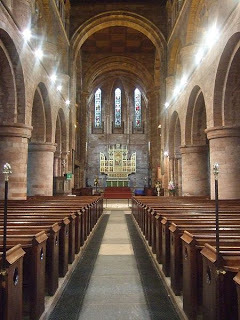 On Saturday, June 8 and Sunday, June 23, Masses were celebrated during the Year of Faith in two former Catholic abbeys. On June 8, the Bishop of Shrewsbury celebrated Mass at Shrewsbury Abbey:
On Saturday, June 8 and Sunday, June 23, Masses were celebrated during the Year of Faith in two former Catholic abbeys. On June 8, the Bishop of Shrewsbury celebrated Mass at Shrewsbury Abbey:The Mass was arranged by the Shrewsbury deanery with the permission of the Church of England and was celebrated by the Rt Rev. Mark Davies, the Bishop of Shrewsbury.
The abbey was full to capacity as hundreds of local Catholics and about a dozen priests turned out for the event on a blazing Saturday afternoon.
The Mass began with the singing of the Te Deum, in which the congregation asked for the intercession of such saints as St Winefride, whose tomb used to lie in the abbey, and such local martyrs as the Elizabethans Blessed Robert Johnson and Blessed Richard Martin.
[Shrewsbury Abbey, the site of Ellis Peter's Cadfael murder mysteries, is an Anglican parish now.]
Shrewsbury Abbey was founded in 1083 and by the early 16th century was one of the most wealthy and important of more than 600 monasteries throughout the country, and was ruled by a “mitred abbot” who also sat Parliament.
It was dissolved in 1540 by King Henry VIII and the shrine of St Winefride, today a patron of the Diocese of Shrewsbury, was desecrated.
Following improvements in ecumenical relations since the Second Vatican Council, Benedictine monks were about a decade ago permitted to celebrate Mass at the abbey for the first time since its dissolution.
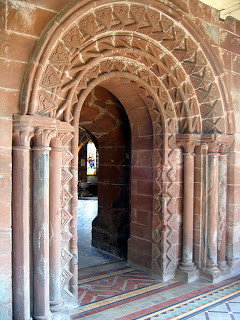 The Mass at Norton Abbey was scheduled to be celebrated in the outdoor ruins of the Augustinian priory, but the weather did not cooperate:
The Mass at Norton Abbey was scheduled to be celebrated in the outdoor ruins of the Augustinian priory, but the weather did not cooperate:Catholics in Cheshire have attended Mass on the site of a Medieval abbey church for only the second time since the Reformation.
The Mass at Norton Priory, Runcorn, was celebrated to mark the Year of Faith opened last October by Pope Emeritus Benedict XVI.
It brought together more than 600 faithful from the five Runcorn churches of the Holy Spirit, Our Lady, St Augustine, St Edward and St Martin de Porres and the Frodsham parish of St Luke that make up Local Pastoral Area 12 of the Diocese of Shrewsbury.
Initially, an outdoor Mass had been planned amid the ruins of the former Augustinian priory but the uncertain weather persuaded organisers to transfer the celebration to the 12th century undercroft. . . .
The Mass was concelebrated by Runcorn priests Fr Peter Wright, who preached, and Fr George Malecki and by Fr Peter O’Neill, the parish priest of St Luke’s. The Rev. Deryck Sankey, a Warrington-based deacon, also attended.
The Mass was also attended by the children of six primary schools, with their families, as well as pupils and teachers from St Chad’s Catholic and Church of England High School, Runcorn.
The congregation included a small group of Kenyans who were visiting Runcorn from St Mary’s Catholic School in Nyeri, which is twinned with St Chad’s. . . .
Norton Priory has now become an acclaimed tourist attraction with an award-winning museum, managed woodland and 18th century walled gardens open to visitors.
Much of the original layout of the buildings – the cloisters, church, refectory and dormitory – can be seen, though few of the original buildings remain standing.
One of the greatest surviving items is an huge statue of St Christopher carrying the child Jesus on his shoulders [pictured in the article] which was preserved by the Brooke family and is now on view at the museum.
The Mass was only the second Mass to be celebrated at the site of the priory since the 16th century.
The first was celebrated by the priest and parishioners of St Augustine’s, Runcorn, about 30 years ago.
These are fascinating historical events! It is good for English Catholics to demonstrate their heritage in their native land, and it is very hospitable for the Church of England pastor to make his church available for the celebration of the Mass--but the church was consecrated for the celebration of Holy Mass and the Sacraments of the Catholic Church, after all!
[Both photos are from wikipedia commons.]
Published on June 24, 2013 22:30
Shrewsbury Masses in Monastic Ruins
 On Saturday, June 8 and Sunday, June 23, Masses were celebrated during the Year of Faith in two former Catholic abbeys. On June 8, the Bishop of Shrewsbury celebrated Mass at Shrewsbury Abbey:
On Saturday, June 8 and Sunday, June 23, Masses were celebrated during the Year of Faith in two former Catholic abbeys. On June 8, the Bishop of Shrewsbury celebrated Mass at Shrewsbury Abbey:The Mass was arranged by the Shrewsbury deanery with the permission of the Church of England and was celebrated by the Rt Rev. Mark Davies, the Bishop of Shrewsbury.
The abbey was full to capacity as hundreds of local Catholics and about a dozen priests turned out for the event on a blazing Saturday afternoon.
The Mass began with the singing of the Te Deum, in which the congregation asked for the intercession of such saints as St Winefride, whose tomb used to lie in the abbey, and such local martyrs as the Elizabethans Blessed Robert Johnson and Blessed Richard Martin.
[Shrewsbury Abbey, the site of Ellis Peter's Cadfael murder mysteries, is an Anglican parish now.]
Shrewsbury Abbey was founded in 1083 and by the early 16th century was one of the most wealthy and important of more than 600 monasteries throughout the country, and was ruled by a “mitred abbot” who also sat Parliament.
It was dissolved in 1540 by King Henry VIII and the shrine of St Winefride, today a patron of the Diocese of Shrewsbury, was desecrated.
Following improvements in ecumenical relations since the Second Vatican Council, Benedictine monks were about a decade ago permitted to celebrate Mass at the abbey for the first time since its dissolution.
 The Mass at Norton Abbey was scheduled to be celebrated in the outdoor ruins of the Augustinian priory, but the weather did not cooperate:
The Mass at Norton Abbey was scheduled to be celebrated in the outdoor ruins of the Augustinian priory, but the weather did not cooperate:Catholics in Cheshire have attended Mass on the site of a Medieval abbey church for only the second time since the Reformation.
The Mass at Norton Priory, Runcorn, was celebrated to mark the Year of Faith opened last October by Pope Emeritus Benedict XVI.
It brought together more than 600 faithful from the five Runcorn churches of the Holy Spirit, Our Lady, St Augustine, St Edward and St Martin de Porres and the Frodsham parish of St Luke that make up Local Pastoral Area 12 of the Diocese of Shrewsbury.
Initially, an outdoor Mass had been planned amid the ruins of the former Augustinian priory but the uncertain weather persuaded organisers to transfer the celebration to the 12th century undercroft. . . .
The Mass was concelebrated by Runcorn priests Fr Peter Wright, who preached, and Fr George Malecki and by Fr Peter O’Neill, the parish priest of St Luke’s. The Rev. Deryck Sankey, a Warrington-based deacon, also attended.
The Mass was also attended by the children of six primary schools, with their families, as well as pupils and teachers from St Chad’s Catholic and Church of England High School, Runcorn.
The congregation included a small group of Kenyans who were visiting Runcorn from St Mary’s Catholic School in Nyeri, which is twinned with St Chad’s. . . .
Norton Priory has now become an acclaimed tourist attraction with an award-winning museum, managed woodland and 18th century walled gardens open to visitors.
Much of the original layout of the buildings – the cloisters, church, refectory and dormitory – can be seen, though few of the original buildings remain standing.
One of the greatest surviving items is an huge statue of St Christopher carrying the child Jesus on his shoulders [pictured in the article] which was preserved by the Brooke family and is now on view at the museum.
The Mass was only the second Mass to be celebrated at the site of the priory since the 16th century.
The first was celebrated by the priest and parishioners of St Augustine’s, Runcorn, about 30 years ago.
These are fascinating historical events! It is good for English Catholics to demonstrate their heritage in their native land, and it is very hospitable for the Church of England pastor to make his church available for the celebration of the Mass--but the church was consecrated for the celebration of Holy Mass and the Sacraments of the Catholic Church, after all!
[Both photos are from wikipedia commons.]
Published on June 24, 2013 22:30
June 23, 2013
June 24: The Puritan and The Jesuit
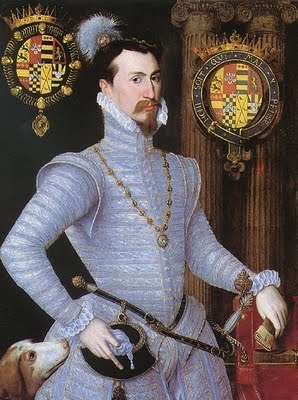 These two men shared the same birthday, the same first name, and the same generation, but little else--except for the general atmosphere of danger in Tudor England.
These two men shared the same birthday, the same first name, and the same generation, but little else--except for the general atmosphere of danger in Tudor England.Robert Dudley, the 1st Earl of Leicester was born on June 24, 1533; Robert Persons or Parsons, SJ on June 24, 1546.
As a young man, Dudley experienced the dangers of the Tudor dynasty. His father was John Dudley, the Duke of Northumberland who encouraged Edward VI to change the succession from Mary OR Elizabeth Tudor to Jane Grey Dudley. His brother was Guildford Dudley who had married Jane Grey. Robert Dudley was imprisoned in the Tower of London after Mary I thwarted that attempt. Although he and another brother were released, his father, brother, and sister-in-law would all be executed for their role in the attempted coup d'etat. Dudley owed his safety to Philip II!
Robert Dudley became one of Elizabeth I's favorites. Between wives, it seemed at some point they might marry, except that the first wife died (Amy Robsart) in such suspicious circumstances. Dudley--or Leicester, as he should be called after his title--was a devout evangelical, a patron of Puritans, who encouraged Elizabeth to join in the war in the Spanish Netherlands between the Protestants and the Catholics there.
Elizabeth thought about arranging a marriage between Leicester and Mary, Queen of Scots as a means of controlling her Catholic cousin, but Mary chose Henry Stuart, Lord Darnley instead. When the Spanish Armada threatened, Leicester was commander of the land forces prepared to defend against the putative landing forces. He died not too long after the failure of the Armada, on September 4, 1588. The Encyclopedia Britannica summaries his character thusly:
Of his character it is more difficult to speak with confidence, but some features of it are indisputable. Being in person tall and remarkably handsome, he improved these advantages by a very ingratiating manner. A man of no small ability and still more ambition, he was nevertheless vain, and presumed at times upon his influence with the Queen to a degree that brought upon him a sharp rebuff. Yet Elizabeth stood by him. That she was ever really in love with him, as modern writers have supposed, is extremely questionable; but she saw in him some valuable qualities which marked him as the fitting recipient of high favours. He was a man of princely tastes, especially in architecture. At court he became latterly the leader of the Puritan party, and his letters were pervaded by expressions of religious feeling which it is hard to believe were insincere. Of the darker suspicions against him it is enough to say that much was certainly reported beyond the truth; but there remain some facts sufficiently disagreeable, and others, perhaps, sufficiently mysterious, to make a just estimate of the man a rather perplexing problem.
Robert Persons, SJ was born of yeoman stock and attended St. Mary's Hall at Oxford, becoming a Fellow and Tutor at Balliol in 1568. His attraction to Catholicism brought about his resignation in 1574; Persons traveled to the Continent and became a Jesuit on July 3, 1575. From 1579 to 1581 he served in England as a missionary priest with St. Edmund Campion. After the latter's arrest and execution, Persons returned to the Continent.
He had high hopes for the success of the Spanish Armada in 1588 and of succeeding William
 Allan as Cardinal--neither of those hopes came to fruition. But his interest in education certainly bore fruit. He founded seminaries in Valladolid, Seville, and Madrid, Spain; he started a school for Catholic boys at St. Omer in France now Stonyhurst in England; he became the rector of the Venerable English College in Rome. Persons died on April 15, 1610. The Catholic Encyclopedia summarizes his character thusly:
Allan as Cardinal--neither of those hopes came to fruition. But his interest in education certainly bore fruit. He founded seminaries in Valladolid, Seville, and Madrid, Spain; he started a school for Catholic boys at St. Omer in France now Stonyhurst in England; he became the rector of the Venerable English College in Rome. Persons died on April 15, 1610. The Catholic Encyclopedia summarizes his character thusly:Father Persons was a man of great parts, eloquent, influential, zealous, spiritual, disinterested, fearless. Yet he had some of the defects of his qualities. He was masterful, sometimes a special pleader, and greater as a pioneer or sectional leader than as Generalissimo. Though his services in the mission field, and in the education of the clergy were priceless, his participation in politics and in clerical feuds cannot be justified except in certain aspects.
More on Father Persons here.
Published on June 23, 2013 22:30
June 22, 2013
A Tudor Biographer Reviewing Another Tudor Biographer's Book, Part II
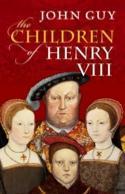 Earlier this month, I posted on one Tudor era biographer reviewing another Tudor era biographer's work--in that case Linda Porter reviewing Anna Whitelock. This time, it's Anna Whitelock reviewing John Guy, who has written biographies of St. Thomas More and his daughter Margaret, Mary, Queen of Scots, and St. Thomas of Canterbury (St. Thomas a Becket). Anne Whitelock reviews John Guy's new study of Henry VIII's children for the BBC History Magazine:
Earlier this month, I posted on one Tudor era biographer reviewing another Tudor era biographer's work--in that case Linda Porter reviewing Anna Whitelock. This time, it's Anna Whitelock reviewing John Guy, who has written biographies of St. Thomas More and his daughter Margaret, Mary, Queen of Scots, and St. Thomas of Canterbury (St. Thomas a Becket). Anne Whitelock reviews John Guy's new study of Henry VIII's children for the BBC History Magazine:Anna Whitelock considers a new look at Henry VIII's children, and how his marital troubles shaped their lives
Henry VIII was a king infamous above all else for his desire for a male heir. The story of Henry’s marital difficulties is well known – as are the children of this most dysfunctional family, who have been the focus of countless individual studies. However, they have not been considered together as often as might be expected. While Guy does not offer much that is significantly new in terms of the detail of the lives of Mary, Edward, Elizabeth and Henry Fitzroy – his first-born son and the illegitimate offspring of his affair with Elizabeth ‘Bessie’ Blount – it is a useful enterprise to bring the king’s children together in one accessible volume.
In doing so the book charts the impact of Henry’s marital difficulties on his offspring. Their formative years were played out in the shadow of high politics, and in vivid descriptions Guy documents how their lives, lifestyles, households, furnishings and education were directly affected by the vagaries of their father’s favour. As this account demonstrates, their childhood and adolescence amounted to an eventful, and traumatic, apprenticeship for rule. . . .
Rather than simply rehearsing the key events of each of the reigns, Guy’s focus is more on the sibling rivalries, conflicting faiths and competing ambitions that tore the family apart during the years that followed. It is a pacy and accessible narrative of the unfolding family drama, but one might have hoped for a little more detail about the personality and rule of each of the children. . . .
This may be a well-known story, but Guy presents it with typical narrative flair and attention to detail, producing a book with obvious appeal.
Read the rest here. This could become a regular series--stay tuned for A Tudor Biographer Reviewing Another Tudor Biographer's Book, Part III!
Published on June 22, 2013 22:30
June 21, 2013
A Lot of St. John Fisher and a Little More
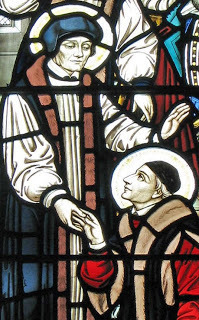 Today is the second day of the U.S. Bishops' 2013 "Fortnight for Freedom" and the Feast of St. John Fisher and St. Thomas More, martyrs, sharing the same feast day. St. John Fisher was executed on June 22, 1535, St. Thomas More on July 6, 1535. Both men's holiness was remarkable at the time of their living and yet they were not canonized until four hundred years later in 1935, on May 19 by Pope Pius XI. Without a free and established Catholicism in England, the devotion to and the cause for all the English martyrs took a long time to develop.
Today is the second day of the U.S. Bishops' 2013 "Fortnight for Freedom" and the Feast of St. John Fisher and St. Thomas More, martyrs, sharing the same feast day. St. John Fisher was executed on June 22, 1535, St. Thomas More on July 6, 1535. Both men's holiness was remarkable at the time of their living and yet they were not canonized until four hundred years later in 1935, on May 19 by Pope Pius XI. Without a free and established Catholicism in England, the devotion to and the cause for all the English martyrs took a long time to develop.Pope Pius XI began his homily at the canonization Mass with the some historical context:
From time to time new heresies make their appearance and, under the guise of truth, gain strength and popularity; but the seamless garment of Christ can never be rent in twain. Unbelievers and enemies of the Catholic faith, blinded by presumption, may indeed constantly renew their violent attacks against the Christian name, but in wresting from the bosom of the militant Church those whom they put to death, they become the instruments of their martyrdom and of their heavenly glory. No less beautiful than true are the words of St. Leo the Great: “The religion of Christ, founded on the mystery of the Cross, cannot be destroyed by any sort of cruelty; persecutions do not weaken, they strengthen the Church. The field of the Lord is ever ripening with new harvests, while the grains shaken loose by the tempest take root and are multiplied.”
Speaking of the two martyrs, Pope Pius said that St. John Fisher "was gifted by nature with a most gentle disposition, thoroughly versed in both sacred and profane lore, so distinguished himself among his contemporaries by his wisdom and his virtue that under the patronage of the King of England himself, he was elected Bishop of Rochester. In the fulfilment of this high office so ardent was he in his piety towards God, and in charity towards his neighbour, and so zealous in defending the integrity of Catholic doctrine, that his episcopal residence seemed rather a Church and a University for studies than a private dwelling."
Of St. Thomas More he said, "he was no less distinguished for his desire of Christian perfection and his zeal for the salvation of souls. Of this we have testimony in the ardour of his prayer, in the fervour with which he recited, whenever he could, even the Canonical Hours, in the practice of those penances by which he kept his body in subjection, and finally in the numerous and renowned accomplishments of both the spoken and the written word which he achieved for the defence of the Catholic faith and for the safeguarding of Christian morality."
The pope also took the opportunity to pray for the conversion of England:
We desire moreover that with your ardent prayers, invoking the patronage of the new Saints, you ask of the Lord that which is so dear to Our heart, namely that England, in the words of St. Paul, "meditating the happy consummation which crowned the life" of those two martyrs, may "follow them in their faith," and return to the Father’s house "in the unity of faith and of the knowledge of the Son of God."
More usually gets more attention, because of the A Man for All Seasons fame (which has its own pitfalls, as Brian Patrick and I discussed yesterday), but Fisher, with even deeper links to the Tudor family (preacher at the funerals of both Henry VIII's father and grandmother) and more consistent and open opposition to Henry's plans to take over the Church and push through his marital arrangement, is just as interesting. He was a humanist, a bishop, a serious defender of Church teaching, and an admired churchman in his lifetime. In his death he demonstrated the same dignity and holiness:
When he came out of the Tower, a summer morning's mist hung over the river, wreathing the buildings in a golden haze. Two of the Lieutenant's men carried him in a chair to the gate, and there they set him down, while waiting for the Sheriffs. The cardinal stood up and leaning his shoulder against a wall for support, opened the little New Testament he carried in his hand. "O Lord," he said, so that all could hear him, "this is the last time I shall ever open this book. Let some comforting place now chance to me whereby I, Thy poor servant, may glorify Thee in my last hour"----and looking down at the page, he read:
Now this is etemal life: that they may know Thee, the one true God, and Jesus Christ Whom Thou has sent I have glorified Thee on earth: I have finished the work which Thou gavest me to do (John, 17:3-4).
Whereupon he shut the book, saying: "Here is even learning enough for me to my life's end." His lips were moving in prayer, as they carried him to Tower Hill. And when they reached the scaffold, the rough men of his escort offered to help him up the ladder. But he smiled at them: "Nay, masters, now let me alone, ye shall see me go up to my death well enough myself; without help." And forthwith he began to climb, almost nimbly. As he reached the top the sun appeared from behind the clouds, and its light shone upon his face. He was heard to murmur some words from Psalm 33: Accedite ad eum, etilluminamim, et facies vestræ non confundentur. The masked headsman knelt----as the custom was----to ask his pardon. And again the cardinal's manliness dictated every word of his answer: "I forgive thee with all my heart, and I trust on Our Lord Thou shalt see me die even lustily." Then they stripped him of his gown and furred tippet, and he stood in his doublet and hose before the crowd which had gathered to see his death. A gasp of pity went up at the sight of his "long, lean, slender body, nothing in manner but skin and bones . . . the flesh clean wasted away; and a very image of death, and as one might say, death in a man's shape and using a man's voice." He was offered a final chance to save his life by acknowledging the royal supremacy, but the Saint turned to the crowd, and from the front of the scaffold, he spoke these words:
Christian people, I am come hither to die for the faith of Christ's Catholic Church, and I thank God hitherto my courage hath served me well thereto, so that yet hitherto I have not feared death; wherefore I desire you help me and assist me with your prayers, that at the very point and instant of my death's stroke, and in the very moment of my death, I then faint not in any point of the Catholic Faith for fear; and I pray God save the king and the realm, and hold His holy hand over it, and send the king a good counsel.
The power and resonance of his voice, the courage of his spirit triumphing over the obvious weakness of his body, amazed them all, and a murmur of admiration was still rustling the crowd when they saw him go down on his knees and begin to pray. They stood in awed silence while he said the Te Deum in praise of God, and the Psalm In Thee O Lord have I put my trust, the humble request for strength beyond his own. Then he signed to the executioner to bind his eyes. For a moment more he prayed, hands and heart raised to Heaven. Then he lay down and put his wasted neck upon the low block. The executioner, who had been standing back, took one quick step forward, raised his axe and with a single blow cut off his head. So copious a stream of blood poured from the neck that those present wondered how it could have come from so thin and wasted a frame. There was certainly Divine irony in the fact that 22 June, the date of the execution, was the Feast of St. Alban, the first Martyr for the Faith in Britain. If the king had realized this he would certainly have arranged for the execution of Cardinal Fisher to take place on another day.
Regarding that last sentence in Michael Davies' account of Fisher's death--Henry VIII had no good choice for a date since he was set on executing this good Cardinal Bishop: June 23 was the Vigil of and June 24 was the Feast of the Nativity of St. John the Baptist! Fisher had identified himself with St. John the Baptist explicitly [meaning that Henry VIII was Herod and Anne Boleyn was Herodias]. So that date would
I'll write more about St. Thomas More on the anniversary of his execution on July 6.
Published on June 21, 2013 23:00
St. John Fisher's Tower Works
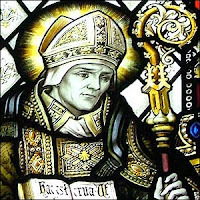 St. Thomas More's devotional writings while in the Tower of London are well-known: A Dialogue of Comfort Against Tribulation; Treatise Upon the Passion; Treatise on the Blessed Body; Instructions and Prayers; De Tristitia Christi. What is not as well known is that St. John Fisher wrote devotional works while in the Tower of London:
St. Thomas More's devotional writings while in the Tower of London are well-known: A Dialogue of Comfort Against Tribulation; Treatise Upon the Passion; Treatise on the Blessed Body; Instructions and Prayers; De Tristitia Christi. What is not as well known is that St. John Fisher wrote devotional works while in the Tower of London: Saint John’s sister, Elizabeth White, was a saintly Dominican nun. While imprisoned in the Tower, he wrote two devotional works for her. One, titled The Ways to Perfect Religion, concluded with seven sentences, each a short prayer intended to be used on successive days of the week. In our consideration of these prayers, we should bear in mind: first, Saint John’s deep reverence for the Holy Name of Jesus, to whom each prayer is addressed; and second, his great devotion to the Daily Office, the official prayer of the Church, which takes into account the liturgical character of each day of the week.
Sunday: O blessed Jesu, make me to love Thee entirely.
Monday: O blessed Jesu, I would fain, but without Thy help I cannot.
Tuesday: O blessed Jesu, let me deeply consider the greatness of Thy love towards me.
Wednesday: O blessed Jesu, give unto me grace heartily to thank Thee for Thy benefits.
Thursday: O blessed Jesu, give me good will to serve Thee and to suffer.
Friday: O sweet Jesu, give me a natural remembrance of Thy Passion.
Saturday: O sweet Jesu, possess my heart, hold and keep it only to Thee.
The other work was titled A Spiritual Consolation . Oxford University Press (not Cambridge?) published an edited volume of his works in 2002:
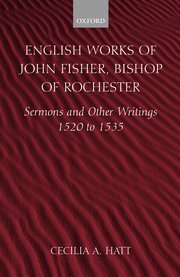 Bishop John Fisher was a scholar and theologian of European reputation, famous as a preacher and author of the first sermon-sequence to be printed in English. He was beheaded for his opposition to Henry VIII's divorce from Catherine of Aragon and pursued after his death by the enmity of the king, who suppressed his books and sought to blacken his name. John Fisher's English writings are distinctive for their structured elegance and clarity. This new edition contains sermons written during the last fifteen years of Fisher's life, including a previously unpublished eyewitness account of the Field of Cloth of Gold celebrations, and devotional works composed while he was a prisoner in the Tower of London.
Bishop John Fisher was a scholar and theologian of European reputation, famous as a preacher and author of the first sermon-sequence to be printed in English. He was beheaded for his opposition to Henry VIII's divorce from Catherine of Aragon and pursued after his death by the enmity of the king, who suppressed his books and sought to blacken his name. John Fisher's English writings are distinctive for their structured elegance and clarity. This new edition contains sermons written during the last fifteen years of Fisher's life, including a previously unpublished eyewitness account of the Field of Cloth of Gold celebrations, and devotional works composed while he was a prisoner in the Tower of London.It was edited by Cecilia A. Hatt and promises that it is/accomplishes three goals:
~The first annotated edition of the English works of John Fisher.
~Sets the theology of this distinguished churchman in its historical context.
~A unique look at the history of the Church during one of its most important stages of development
In the chapter on the Tower Works, Hatt puts them in perspective:
A spiritual consolation and The ways to perfect religion were written while John Fisher was imprisoned in the Tower of London. He composed them for the use of his half‐sister Elizabeth White, who was a nun in the Dominican house at Dartford. The introduction explains the literary and religious background, of the ars moriendi and the meditatio mortis, and the commentary points out resemblances with the work of Henry Suso.
Readers of Nancy Bilyeau's novels The Crown and The Chalice, might remember that the protagonist, Joanna Stafford, was a novice at Dartford Priory, the only house of Dominican nuns in England, suppressed in the Dissolution of the Monasteries!
Published on June 21, 2013 22:30
June 20, 2013
Fortnight for Freedom: Saints John Fisher and Thomas More
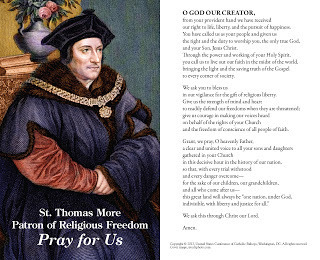
I'll be on the Son Rise Morning Show this morning at 6:45 Central, 7:45 Eastern to discuss the connections among the 2013 Fortnight for (Religious) Freedom, Saints John Fisher and Thomas More (on the vigil of their feast as martyrs), and the true definition of conscience. As you know, you can listen live on-line.
As Ryan Topping notes in his Rebuilding Catholic Culture , for as much good as Robert Bolt's play A Man for All Seasons has done to make St. Thomas More well known, the play has also done harm because of its modern view of conscience, which Blessed John Henry Newman identified in the nineteenth century as “a creation of man”. This view of conscience Newman calls “the right of self will.” It thinks of conscience as the individual’s “right of thinking, speaking, writing, and acting, according to their judgment or their humour, without any thought of God at all” so that everyone is “to be his own master in all things, and to profess what he pleases, asking no one's leave”. Newman also calls this view of conscience, in contrast to true conscience, as being "consistent with oneself"--and that's the form of conscience in Thomas More that Robert Bolt prizes. It's his individual claim, his independent freedom, that Robert Bolt wanted to depict--Thomas More as "hero of selfhood" (from the Preface; cited by Topping on page 129). (Newman quotes from his famous Letter to the Duke of Norfolk.)
Bishop John Fisher and Sir Thomas More did not argue for their freedom of conscience from that position. Their consciences were reflecting natural law and God's revelation, and both spoke on the worldwide tradition and current Catholic teaching to back up their decision not to swear either the Oath of Succession or the Oath of Supremacy (both of which denied the authority of the Pope on the matter of judging the sacramental validity of marriage). Transcripts of their trials indicate that both of them cited the authority of tradition and Christendom against Henry VIII:
St. Thomas More: "I see no reason why that thing should make any Change in my Conscience: for I doubt not, but of the learned and virtuous Men now alive, I do not speak only of this Realm, but of all Christendom, there are ten to one of my mind in this matter; but if I should take notice of those learned Doctors and virtuous Fathers that are already dead, many of whom are Saints in Heaven, I am sure there are far more, who all the while they lived thought in this case as I do now. And therefore, my Lord, I do not think my self bound to conform my Conscience to the Counsel of one Kingdom, against the general Consent of all Christendom."
St. John Fisher: "My lords, I am here condemned before you of high treason for denial of the King's supremacy over the Church of England, but by what order of justice I leave to God, Who is the searcher both of the king his Majesty's conscience and yours; nevertheless, being found guilty, as it is termed, I am and must be contented with all that God shall send, to whose will I wholly refer and submit myself. And now to tell you plainly my mind, touching this matter of the king's supremacy, I think indeed, and always have thought, and do now lastly affirm, that His Grace cannot justly claim any such supremacy over the Church of God as he now taketh upon him; neither hath (it) been seen or heard of that any temporal prince before his days hath presumed to that dignity; wherefore, if the king will now adventure himself in proceeding in this strange and unwonted case, so no doubt but he shall deeply incur the grievous displeasure of the Almighty, to the great damage of his own soul, and of many others, and to the utter ruin of this realm committed to his charge, wherefore, I pray God his Grace may remember himself in good time, and harken to good counsel for the preservation of himself and his realm and the quietness of all Christendom."
Last year, at the opening Mass for the Fortnight for Freedom in Baltimore, Maryland, Archbishop William Lori gave the homily. I'm sure that in some way tonight at the opening Mass at the Baltimore Basilica, he will recall these two great saints in some way. (I have to admit that when I watched that homily last year, one of my first thoughts was--"Not Tyburn Hill! They were beheaded on Tower Hill!")
Published on June 20, 2013 22:30
June 19, 2013
The View from the Organist's Bench: Roger Scruton on Anglicanism

I have heard of Roger Scruton as a philosopher who writes on beauty and is associated with tradition and conservative theories, in general, about society and economics. Last year his book Our Church: A Personal History of the Church of England was published by Atlantic Books:
For most people in England today, the church is simply the empty building at the end of the road, visited for the first time, if at all, when dead. It offers its sacraments to a population that lives without rites of passage, and which regards the National Health Service rather than the National Church as its true spiritual guardian.
In Our Church, Roger Scruton argues that the Anglican Church is the forlorn trustee of an architectural and artistic inheritance that remains one of the treasures of European civilization. He contends that it is a still point in the centre of English culture and that its defining texts, the King James Bible and the Book of Common Prayer are the sources from which much of our national identity derives. At once an elegy to a vanishing world and a clarion call to recognize Anglicanism's continuing relevance, Our Church is a graceful and persuasive book.
Alas, Diarmaid MacCulloch does not quite agree with that last sentence in the publisher's blurb. Reviewing the book in The Guardian , he begins with a statement of common experience and outlook:
I begin this review with a declaration of interest. Roger Scruton and I are rather alike. When very young, we watched our present queen's coronation on small black-and-white televisions, our first experience of the medium. We are both church organists, both distrust confident religious dogma and clerical pretensions, both love the Church of England in a grumpy fashion, and we have both been known to cultivate a fogeyish image on occasion.
MacCulloch comments that it's because they share so much in common that he cannot accept Scruton's version of the history of the Church of England, even if it is a "personal history":
A fundamental problem is that he persistently refers to "the Anglican church" throughout his account of its history since 1533, with a further implication that even before that, Anglicanism had always been sitting in the cupboard under the stairs, waiting for the pope to go away. Augustine of Canterbury, sent by Pope Gregory in 597 to establish Roman authority in the old imperial provinces of Britannia, would have been puzzled to learn that his mission had created such a body.
A millennium after Augustine, during the 16th-century reformation, we still couldn't talk about "Anglicanism" – only about the Church of England. Anglicanism really didn't take shape until some determined reconstruction in 1660-62. Previously, it was a "reformed" Protestant church of the European reformation – "reformed", technically, because it wasn't Lutheran – and it looked much to the reformed church in Zurich, a city that doesn't get a mention in Scruton's account, though Geneva does, excessively. The Tudor C of E lacked qualities Scruton admires: tolerance and an embrace of the "middle way". Its bishops ordered images and stained glass to be smashed, a regrettable vandalism that Scruton attributes to some vaguely characterised fanatical thugs called "Puritans". Tudor and Stuart England executed more Roman Catholics than any other Protestant church in Europe, and burned Anabaptists too, besides later dispatching quite a few Scottish Covenanters. The English church was not a "middle way" between the pope and Protestantism, because, as its leaders would brutally have made clear to Scruton, you can't have a middle way between the Antichrist and truth.
And MacCulloch continues, even though he apologizes for "breaking a butterfly upon a wheel" and does commend some parts of the book: "When he genuinely knows about something, other rewards appear: some enjoyably sensitive pages on the feel of a country church, church architecture generally, and some mostly accurate discussion of church music."
Read the rest here. Spoiler alert: MacCulloch does NOT approve of the Anglican Ordinariate.
Published on June 19, 2013 22:30
June 18, 2013
Blessed John Henry Newman on Preaching and Words

I am sure you have heard the statement often attributed to St. Francis of Assisi: "Preach the Gospel at all times. Use words if necessary." As this blog notes, it can be cited with a certain edge and even a semi-political tone:
It is always attributed to St. Francis of Assisi---founder of the Franciscan Order---and is intended to say that proclaiming the Gospel by example is more virtuous than actually proclaiming with voice. It is a quote that has often rankled me because it seems to create a useless dichotomy between speech and action. Besides, the spirit behind it can be a little arrogant, intimating that those who "practice the Gospel" are more faithful to the faith than those who preach it.
And, of course, St. Francis never said it. But in using the book compiled by Father Benedict Groeschel, Praying to Our Lord Jesus Christ, particularly during my weekly hour of adoration of Jesus in the Blessed Sacrament, I re-read (re-prayed?) this prayer by Blessed John Henry Newman, in which the English saint goes even further in contrasting actions and words in preaching, in the circumstances of everyday life:
"Make me preach you without preaching-not by words, but by my example and by the catching force, the sympathetic influence, of what I do - by my visible resemblance to your saints, and the evident fullness of the love which my heart bears to you."
Without over-analyzing the prayer, I would comment that this is an emblem of Newman's motto as Cardinal, "Cor ad cor loquitor"--"Heart Speaks to Heart", a motto he borrowed from St. Francis de Sales. Recalling that Blessed John Henry Newman, particularly because of the Parochial and Plain Sermons collected from his years as an Anglican, is known as a great preacher, means that Newman meant that this is true: he should preach without preaching at all. Knowing that he also did preach by preaching means that formal preaching and teaching is required, but this personal, heart-to-heart example and influence is essential.
The entire prayer, "Jesus the Light of the Soul" from Meditations and Devotions:
Stay with me, and then I shall begin to shine as you shine: so to shine as to be a light to others. The light, O Jesus, will be all from you. None of it will be mine. No merit to me. It will be you who shines through me upon others. O let me thus praise you, in the way which you do love best, by shining on all those around me. Give light to them as well as to me; light them with me, through me. Teach me to show forth your praise, your truth, your will. Make me preach you without preaching-not by words, but by my example and by the catching force, the sympathetic influence, of what I do - by my visible resemblance to your saints, and the evident fullness of the love which my heart bears to you.
Father Groeschel's collection of prayers from the early Church to the twentieth century, from the martyrs to Blessed John Paul II, from the Fathers of the Church through the saints of the Middle Ages and each age of Church, is not really a book to be read through, since it's a book of prayers to inspire prayer and meditation. I am, however, reading the introductions to the sections as an excellent survey of the history of spirituality.
Published on June 18, 2013 22:30
June 17, 2013
The Ruins of Netley Abbey by George Keate
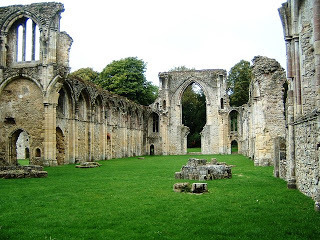
Nancy Bilyeau is posting a series on the monastic ruins of England at a site called A Bloody Good Read and uses the evocative line, "In Lone Magnificence, a Ruin Stands" for the posts. It's from a poem by George Keate:
Hence all the trivial Pleasures of the Crowd,
Folly's vain Revel, and that treach'rous Art
Which captivates the Gay, or sooths the Proud,
And steals each better Purpose from the Heart.
More welcome far the Shades of this wild Wood
Skirting with cheerful Green the seabeat Sands,
Where NETLEY, near the Margin of the Flood
In lone Magnificence a Ruin stands.
How chang'd alas! from that rever'd Abode
Which spread in ancient Days so wide a Fame,
When votive Monks these sacred Pavements trod,
And swell'd each Echo with JEHOVAH'S Name!
Now sunk, deserted, and with Weeds o'ergrown,
Yon aged Walls their better Years bewail;
Low on the Ground their loftiest Spires are thrown,
And ev'ry Stone points out a moral Tale.
Mark how the Ivy with Luxuriance bends
Its winding Foliage through the cloister'd Space,
O'er the green Window's mould'ring Height ascends,
And seems to clasp it with a fond Embrace.—
With musing Step I pace the silent Isle,
Each moss-grown Nook, each tangled Path explore,
While the Breeze whistles through the shatter'd Pile,
Or wave light-dashing murmurs on the Shore.
No other Noise in this calm Scene is heard,
No other Sounds these tranquil Vaults molest,
Save the Complainings of some mournful Bird
That ever loves in Solitude to rest.
Haunts such as these delight, and o'er the Soul
Awhile their grateful Melancholy cast,
Since through all Periods she can boundless roll,
Enjoy the Present, and recall the Past!—
Here, pious Hermits from the World retir'd
In Contemplation wing'd their Thoughts to Heav'n;
Here, with Religion's heart-felt Raptures fir'd,
Wept o'er their erring Days, and were forgiv'n.
Race after Race succeeding, in these Cells,
Learn'd how to value Life, learn'd how to die;
Lost are their Names, and no Memorial tells
In what lone Spot their mould'ring Ashes lie!
Mute is the matin Bell which us'd to call
The wakeful Fathers from their humble Beds;
No midnight Taper glimmers on the Wall,
Or o'er the Floor its trembling Radiance sheds!
No sainted Shrine now pours its Blaze of Light
Bidding the zealous Bigot hither roam;
No holy Relick glads the Pilgrim's Sight,
Or lures his Foot-steps from a distant Home!—
Now fainter to the View each Object grows,
In the clear West the Day's last Gleams are seen,
On Night's dim Front the Star of Ev'ning glows,
And dusky Twilight aids the solemn Scene.
Again quick Fancy peoples all the Gloom,
Calls from the Dust the venerable Dead,
Who ages since lay shrouded in the Tomb,
And bids them these accustom'd Limits tread.
Swift as her Wish the shadowy Forms appear,
O'er each chang'd Path with doubtful Step they walk,
From their keen Eyes she sees Amazement stare,
And hears, or thinks she hears, the Spectres talk.
E'en now they pass, and fading like a Dream
Back to their hallow'd Graves again they go;
But first bequeath one pitying Sigh, and seem
To mourn with me the Fate of all below!—
Disparted Roofs that threaten from above,
The tott'ring Battlement, the rifted Tow'r,
With many a scatter'd Fragment loudly prove,
All conqu'ring TIME, the Triumphs of thy Pow'r.
These speaking Stones one sacred Truth maintain,
That Dust to Dust is Man's predestin'd Lot;
He plans, and labours, — Yet how much in vain!—
Himself, his Monuments, how soon forgot!—
Forgot on Earth, — but one there sits on high
Who bids our Virtues to his Throne ascend,
Pleas'd he beholds them with Parent's Eye,
To give our Hope new Wings, and crown our End!—
And you, YE FAIR, of gayer Scenes the Grace,
If Chance should lead you from the jocund Train,
Curious to visit this sequester'd Place,
Amidst its Ruins wander not in vain.
Whence do they still our silent Wonder claim
E'en in this low, this desolated State?
'Tis from Remembrance of their former Fame:—
They once were beautiful, they once were great!
'Tis Goodness best adorns the female Heart;
Asks a Respect which must with Years increase,
Lives, when the Roses from the Cheek depart,
And all the Joys of Adulation cease!
Forgive the Muse, if with an anxious Love
She wooes you to attend her friendly Lay;
Warns you, lest faithless to yourselves ye prove,
And in false Pleasures trifle Life away.
Know, in your Breasts is lodg'd a Spark divine
For ever prompting to each great Desire;—
Th' inconstant World must change, that still shall shine,
Nor Death's cold Hand e'er quench th' immortal Fire.
Ne'er may Dishonour's Blast an Entrance find,
O keep it sacred with a Vestal's Care,
Feed it with all the Graces of the Mind,
Nor fail to pour the social Duties there.
So o'er your Forms when TIME his Veil shall cast,
And ev'ry Charm by Age shall be decay'd,
Your fair Renown shall triumph to the last,
And Virtue guard the Conquests Beauty made.
According to Wikipedia, "Netley Abbey is a ruined late medieval monastery in the village of Netley near Southampton in Hampshire, England. The abbey was founded in 1239 as a house for Roman Catholic monks of the austere Cistercian order. Despite being a royal abbey, Netley was never rich, produced no influential scholars nor churchmen, and its nearly 300-year history was quiet. The monks were best known to their neighbours for the generous hospitality they offered to travelers on land and sea." (photo also from Wikipedia) Netley Abbey is on the English Heritage list.
Published on June 17, 2013 22:30



